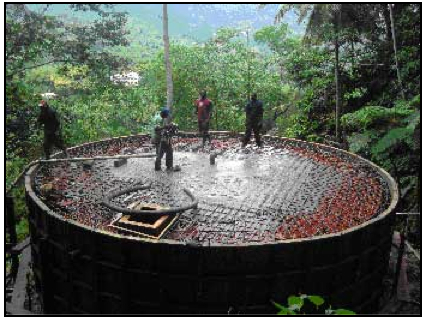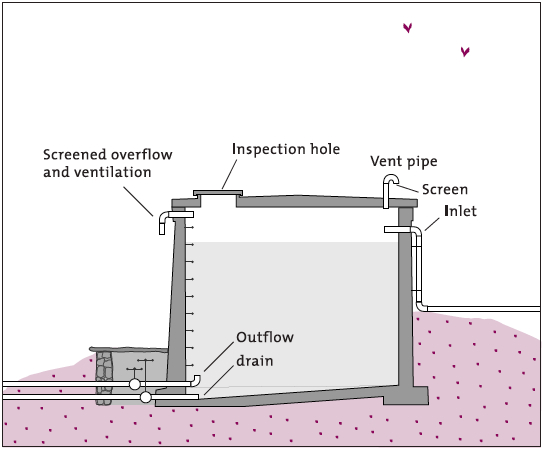Difference between revisions of "Reinforced concrete reservoir"
(→Manuals, videos and links) |
(→Manuals, videos and links) |
||
| Line 30: | Line 30: | ||
* [http://www.africaexchange.org/dev_projects.html APPROPRIATE TECHNOLOGY SOLUTIONS]. Africa Exchange water projects (includes elevated tank). | * [http://www.africaexchange.org/dev_projects.html APPROPRIATE TECHNOLOGY SOLUTIONS]. Africa Exchange water projects (includes elevated tank). | ||
* [http://www.scribd.com/doc/34620508/Designing-an-Elevated-Water-Storage-Tank-for-Developing-Countries Designing an Elevated Storage Tank]. Technical Note No. RWS. 5.0.3. Water for the World. | * [http://www.scribd.com/doc/34620508/Designing-an-Elevated-Water-Storage-Tank-for-Developing-Countries Designing an Elevated Storage Tank]. Technical Note No. RWS. 5.0.3. Water for the World. | ||
| + | * [http://water.me.vccs.edu/courses/env110/lesson10.htm Lesson 10: Water Tank Design and Maintenance]. Mountain Empire Community College. | ||
==Acknowledgements== | ==Acknowledgements== | ||
* Brikke, François, and Bredero, Maarten. [http://www.washdoc.info/docsearch/title/117705 Linking technology choice with operation and maintenance in the context of community water supply and sanitation: A reference document for planners and project staff] or ([http://www.who.int/water_sanitation_health/hygiene/om/wsh9241562153/en/ alternative link]). World Health Organization and IRC Water and Sanitation Centre. Geneva, Switzerland 2003. | * Brikke, François, and Bredero, Maarten. [http://www.washdoc.info/docsearch/title/117705 Linking technology choice with operation and maintenance in the context of community water supply and sanitation: A reference document for planners and project staff] or ([http://www.who.int/water_sanitation_health/hygiene/om/wsh9241562153/en/ alternative link]). World Health Organization and IRC Water and Sanitation Centre. Geneva, Switzerland 2003. | ||
* CARE Nederland, Desk Study: [[Resilient WASH systems in drought-prone areas]]. October 2010. | * CARE Nederland, Desk Study: [[Resilient WASH systems in drought-prone areas]]. October 2010. | ||
Revision as of 06:35, 17 May 2013
Reinforced concrete reservoirs are used to store clean water for release on demand. They are usually made of concrete reinforced with steel bars or steel mesh, although some low-cost construction techniques use bamboo or other materials to reinforce the concrete. Reservoirs may also be made of masonry, or ferrocement. Chemical additives are often mixed with the concrete to make it more impermeable to water. Reinforced concrete reservoirs are built at the site on a solid foundation. If the base is not solid enough, another site should be chosen, or arrangements made to stabilize the construction.
To protect the water from contamination, the reservoir is covered with a roof, usually made of reinforced concrete, but other materials can be used. In the top of the tank an aeration pipe with a screen allows fresh air to circulate in the tank, but keeps rodents and insects out. A manhole in the roof allows access to the tank for cleaning and repairs. Water flows into the reservoir through an inlet pipe above the water level in the reservoir. This prevents back-flow and allows the water to be heard entering the tank. At this point, a chlorine solution is often added for disinfection. Outlets are built a little above the floor of the reservoir, which has a slope pitched down towards one point with a washout pipe for flushing.
Suitable conditions
Use: For reservoirs larger than about 3 m3 where sand, cement, gravel and reinforcing materials are available.
Resilience to changes in the environment
Drought
Effects of drought: Badly made concrete and cracked linings (e.g. in tanks, dams, waterways, wells, and other structures).
Underlying causes of effects: Less water used for curing; Impure water used for mixing.
To increase resiliency of WASH system: Ensure adequate mixing, ratios, purity of ingredients; Minimize water content in mixture; Ensure adequate curing.
For more information on drought: Resilient WASH systems in drought-prone areas
Construction, operations and maintenance
Range of depth: Usually between 1.5–3.0 m. Expected useful lifetime: 30 years.
Operation consists of opening and closing the valves, and managing a chlorinator, if provided. If the reservoir does not deliver directly to a tap, water distribution is usually carried out by a caretaker. A well-designed and well-built reservoir needs very little maintenance. The surroundings must be kept clean on a regular basis; every two months the valves must be closed and opened to prevent them from sticking, and the screens must be checked. Occasionally, a screen or tap may need to be repaired. Once a year, or sooner if contamination is suspected, the reservoir must be drained, de-silted, cleaned with a brush and disinfected with chlorine. Any leaks or cracks in the concrete have to be repaired as soon as possible. If needed, a caretaker can be appointed to regulate the inflow and outflow. A concrete reservoir has few other organizational requirements.
Manuals, videos and links
- APPROPRIATE TECHNOLOGY SOLUTIONS. Africa Exchange water projects (includes elevated tank).
- Designing an Elevated Storage Tank. Technical Note No. RWS. 5.0.3. Water for the World.
- Lesson 10: Water Tank Design and Maintenance. Mountain Empire Community College.
Acknowledgements
- Brikke, François, and Bredero, Maarten. Linking technology choice with operation and maintenance in the context of community water supply and sanitation: A reference document for planners and project staff or (alternative link). World Health Organization and IRC Water and Sanitation Centre. Geneva, Switzerland 2003.
- CARE Nederland, Desk Study: Resilient WASH systems in drought-prone areas. October 2010.


